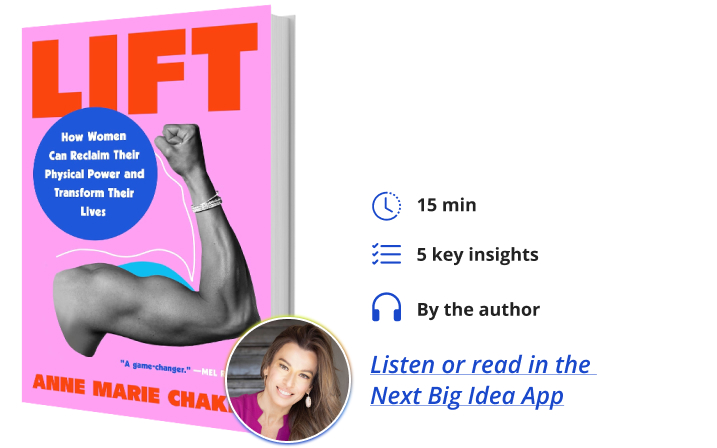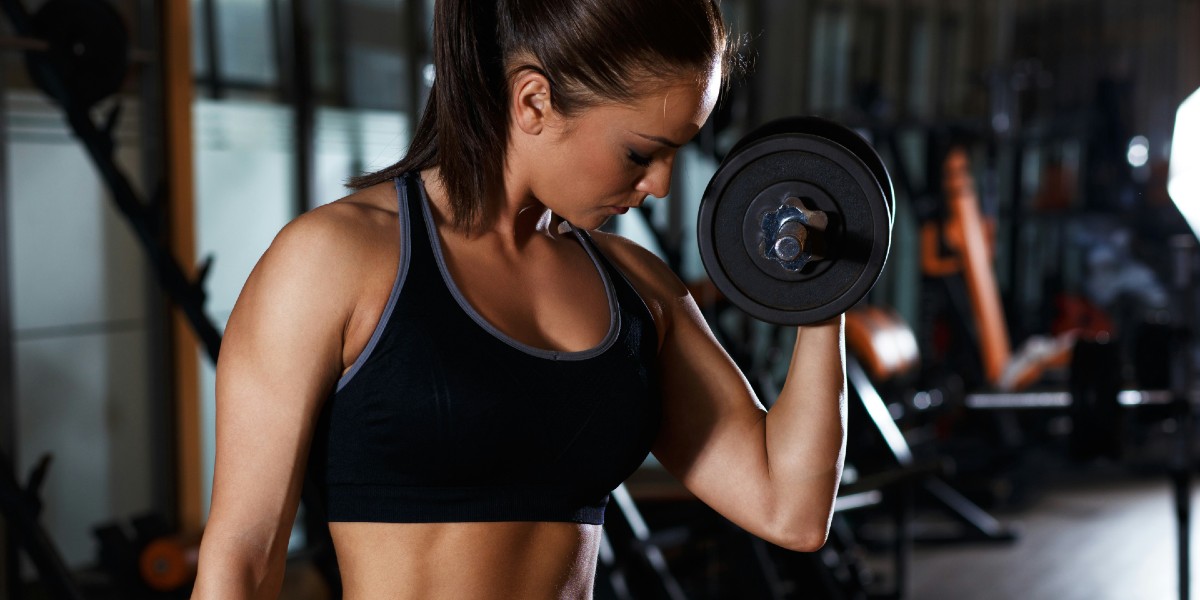Anne Marie Chaker is a veteran journalist and former longtime reporter for The Wall Street Journal, where she covered health, wellness, and the changing lives of women. After leaving journalism, she became a professionally ranked bodybuilder at age 50. Now, she’s using her platform to change the way we think about strength and aging. She’s also the co-host of a new SiriusXM show about power, reinvention, and taking up space in the world, also called LIFT.
What’s the big idea?
For decades, women have been taught to shrink themselves—physically, emotionally, and socially. The ideal woman was thin, quiet, and agreeable. But what if the key to power is not less, but more? In LIFT, Anne Marie Chaker reclaims muscle for women, arguing that a woman’s wellness journey should be about building oneself, rather than reducing. Weaving together cultural history, cutting-edge science, and her own journey from burnout to bodybuilder, she argues that strength isn’t just for athletes or aesthetics: it’s a new model for living, especially for women in midlife and beyond.
Below, Anne Marie shares five key insights from her new book, LIFT: How Women Can Reclaim Their Physical Power and Transform Their Lives. Listen to the audio version—read by Anne Marie herself—below, or in the Next Big Idea App.

1. Women were never meant to be thin.
For most of human history, women weren’t meant to be thin—they were meant to be strong. That was the takeaway for me from discovering the work of Alison Murray, an anthropology professor at the University of Victoria in Canada. While studying prehistoric human remains, she made a startling discovery about women’s bodies: they were buff. When comparing prehistoric women to modern ones, Murray found their bone structure most closely resembled that of today’s elite rowers—evidence of regular, load-bearing activity and a sign that women played a major role in the development of agriculture, not just as passive “gatherers.”
Our cultural obsession with skinniness is a recent invention, born of fashion, patriarchy, and postwar consumerism. It’s a story that begins with greater access to food, late 19th-century warnings about “corpulence,” the rise of dieting as a moral virtue, and the invention of the calorie—all of which paved the way for modern food restriction.
It’s time to dismantle the myth of the “weaker sex” and rewrite the story. Women’s bodies were built for endurance, resilience, and longevity. Reclaiming that truth is the first step toward real strength.
2. How women are stronger than men.
The problem with most research on women’s strength is…we don’t have much of it. A 2021 paper analyzing all sports science research published in six journals between 2014 and 2020 found that, out of the 12.5 million total participants, only one-third were women. But the glimmers we do have suggest that women possess a unique kind of physical capacity. In many ways, we are tougher than and able to outlast men.
Yes, men tend to have bigger hearts and more upper-body strength. But studies show women can better withstand fatigue, performing at the same intensity for a longer period of time. A 2016 review of over 55 fatigue studies conducted between 1972 and 2015 found that, on average, women outlasted men by 36 percent in endurance-based tasks.
Then there’s the unique story of female longevity. Across cultures and throughout time, women consistently outlive men by anywhere from 5 to 20 percent. The reasons aren’t fully understood, but the pattern is clear.
“In many ways, we are tougher than and able to outlast men.”
History offers clues, too. Evidence suggests women weren’t just gatherers; they hunted, often in cooperative groups using a range of tools with remarkable skill. (Men typically hunted either alone or with one other person and with a single weapon.)
One of my favorite stories deals with a Viking grave unearthed in Birka, Sweden more than a century ago. It was assumed to belong to a male warrior, given its contents—armor, weapons, even gaming pieces used for strategic planning. But in 2017, DNA testing revealed that the warrior was a woman, and likely a respected leader.
What I love about that story is how clearly it shows the ease with which we view history through a male-forward lens. But the evidence tells a different story: in earlier times, women were seen, and treated, as the strong badasses we were.
3. Muscle is medicine.
Muscle isn’t just about looking strong; it’s about staying alive. More muscle is linked to better sleep, stronger bones, sharper brain function, and even a longer life. Yet we naturally lose it as we age. The good news? We can rebuild it, even in our later years. Strength training is no longer optional; it’s essential, especially for women.
Take sleep. A study by Iowa State University found that participants who engaged in 60 minutes of resistance training three times a week for a year slept longer and fell asleep faster than those who performed cardio alone or even a combination of cardio and strength training. Resistance training also improves brain health, boosting memory, focus, and reaction time. It helps produce new brain cells in the hippocampus and releases irisin, a hormone that supports cognitive function.
“Resistance training also improves brain health, boosting memory, focus, and reaction time.”
Exercise also protects against aging on a cellular level. It helps lengthen telomeres, the protective caps on chromosomes that shorten with age, slowing the biological clock.
For women, strength training is especially critical. During menopause, women can lose up to 20 percent of their bone density, increasing the risk of fractures and long-term decline. The pulling and pushing of strength training provides the stress bones need to rebuild and stay strong. In other words, when you build muscle, you’re building bone too. Muscle is one of the most powerful tools we have to fight aging, disease, and decline.
4. You have to eat to lift.
Building muscle takes more than movement—it takes nourishment. That means eating enough protein and calories, and doing so consistently, to support recovery and growth. For women used to dieting or restriction, this can feel radical: eating more to become more. But the shift from scarcity to strength starts on the plate.
The basics aren’t glamorous. It’s about eating mostly whole foods and prepping meals in advance so you have ready access to carbs, proteins, and fats when hunger strikes. Like many bodybuilders, I think in terms of macronutrients: roughly 50 percent carbs, 30 percent protein, and 20 percent fat. When I’m preparing for a competition, those ratios shift, but in general, that’s my baseline.
Protein is the macronutrient I prioritize most, and it’s what people ask about most, too. It’s essential for muscle growth, satiety, and bone health. Most women don’t get enough. Social conditioning plays a role: we’ve been taught to order the salad, while protein-rich foods like steak have long been associated with masculinity.
The U.S. Food and Nutrition Board recommends 0.8 grams of protein per kilogram of body weight, but if you’re lifting regularly and trying to build muscle, a better target is closer to one gram per pound of ideal body weight. Not only does protein help rebuild tissue, it helps regulate hunger hormones like ghrelin and supports bone density. Some research suggests that women benefit from intakes around 1.2 grams per kilogram of body weight to preserve bone mass and calcium retention as they age. Eating to build muscle isn’t indulgent—it’s intentional. And it’s powerful.
5. Start lifting.
Strength training doesn’t require a gym, a trainer, or a perfect body. All it requires is a willingness to begin. Whether you’re picking up dumbbells at home or deadlifting at 65, lifting is a mindset shift. It’s about seeing yourself as capable, powerful, and worth the effort. And once you start, you won’t want to stop.
You don’t need fancy equipment to begin. Mine is all used, purchased off Craigslist. Start with bodyweight—if you’ve got a body, you’ve got a gym. From there, you can add bands, dumbbells, a barbell, or all of the above.
Here are a few things I keep in a corner of my basement:
- Resistance bands. Inexpensive, portable, and surprisingly effective. A 2019 Brazilian study found they build strength just as well as machines or dumbbells. I keep mine near the TV and in my suitcase. They’re perfect for targeting smaller muscle groups.
- Kettlebell . I only have one, but that’s enough. The swinging motion gives a full-body workout, especially for the posterior chain (your backside). It’s rhythmic, fun, and hits the core, too.
- Barbells and dumbbells. The classics. These free weights recruit stabilizer muscles and challenge your whole body. Add a squat rack for safer, heavier lifts like squats and presses.
- Bench. A simple adjustable bench opens up a range of movements: incline presses, rows, and more. It’s a small upgrade that makes a big difference.
Start where you are, use what you have, and watch what happens when you choose to get strong.
Enjoy our full library of Book Bites—read by the authors!—in the Next Big Idea App:





























